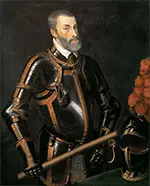Charles V: Holy Roman Emperor and Spanish Monarch
Part 2: Worldwide Fame At the same time, Charles faced trouble in Spain. In 1520–1521, a large number of Spanish people in Castile took up arms in revolt (known as the Revolt of the Comuneros) and eventually seized control of the cities of Toledo, Tordesillas, and Valladolid. Charles's leaving the country to take up his duties as ruler of Austria in 1519 had left the door open for such an uprising. The people in revolt wanted Joanna, by then locked away in a royal castle, as their ruler. Forces loyal to Charles struck back, eventually defeating the rebel forces at the pivotal Battle of Villalar. Royal troops captured three prominent rebel leaders and had them killed, all but ending the resistance. Royal troops rounded up the rest of the rebels by the end of the year. Charles also faced down two other uprisings, in different places in the empire. Early on his reign, he defeated a rebellion in Frisian lands. In the same part of Europe, in 1540 he put down a rebellion in Ghent. Another primary foe of Charles was France's King Francis I. That monarch had hoped to be named Holy Roman Emperor but was passed over in favor of Charles. Francis, as well, was very much involved in fighting the Italian Wars. Ferdinand II of Aragon had also been King of Naples, Sardinia, As a result of the latter battle (a resounding French defeat), Francis was one of many French soldiers taken prisoner. Charles ordered Francis to be taken to Madrid and put under house arrest. The French king ended his captivity (relatively lenient though it was, because of his royal status) by signing the 1526 Treaty of Madrid, out of which he gave up all claims to Burgundy, Flanders, and Italy. Back in France, Francis broke his promise and rounded up another army. Stocking this one were a coalition of soldiers from England, France, Milan, the Papal States, and Venice. Fighting began in 1527, but the result was the same. Spanish victories forced Francis to sign yet another treaty, the 1529 Treaty of Cambrai, which reiterated the terms of the previous treaty but also stipulated that Francis's two sons would go to Madrid as prisoners and that France would have to pay Spain 2 million gold crowns. Francis just couldn't let things go. Even though he had married Eleanor of Portugal, Charles's sister, the French king still had it in for the emperor-monarch. In 1536, Francis formed yet another alliance, this one with the Ottoman leader Khayr ad-Din. Yet again, Spain prevailed, taking more territory from both opponents. Spanish troops occupied Provence and parts of northern France. Charles and France signed a treaty at Nice in 1538. 
The enmity continued. Francis found yet another ally, in the Schmalkaldic League, whose German members, Protestants all, considered the Catholic Charles V an enemy. Again, Spain prevailed. The only thing that ended the Franco-Spanish conflict was the death of Francis, which came in 1547. It was eight years later that Charles and the Schmalkaldic League agreed the Peace of Augsburg, settling the religious struggle with an uneasy peace that cemented within the Holy Roman Empire the Catholic-Protestant divide. During the wars with France, Charles was also at odds with Pope Clement VII, who like his predecessor, Leo X, had far preferred the French king to be Holy Roman Emperor. Clement VII, in fact, had gone into alliance with Francis (and Florence and Milan, in the League of Cognac), against Charles. Charles did not forgive either slight and, at the head of an army in 1527, sacked Rome and imprisoned Clement VII. Charles also played a leading role in fighting against the surging Ottoman Empire and its dynamic sultan Suleiman the Magnificent. After the desperate European raising of the Siege of Vienna in 1529, Charles led a counter-attack across the Danube River and later conquered Tunis and threatened Algiers. In the same year that France's King Francis I died, Charles admitted defeat, signing a treaty that gave the Ottoman Empire control of Hungary and the promise of a large amount of money. Charles had been selected Holy Roman Emperor in 1530. The following year, he set about trying to suppress Protestantism in the Low Countries. Next page > Final Years > Page 1, 2, 3 |
|
Social Studies for Kids
copyright 2002–2024
David White



 and Sicily; and Charles V had inherited those thrones from his father. France at this time controlled the Duchy of Milan; Charles, however, wanted a say in who ruled Milan. France and Spain eventually went to war in this dispute. Spanish armies seized control of Toulon and other areas in the southeast. Continuing on into Italy, Spain took Milan in 1522 and then Pavia in 1525.
and Sicily; and Charles V had inherited those thrones from his father. France at this time controlled the Duchy of Milan; Charles, however, wanted a say in who ruled Milan. France and Spain eventually went to war in this dispute. Spanish armies seized control of Toulon and other areas in the southeast. Continuing on into Italy, Spain took Milan in 1522 and then Pavia in 1525.
